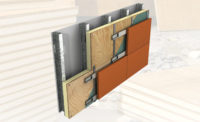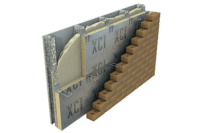In the London Underground, signs and audio recordings implore subway riders to “mind the gap”—in other words, to avoid stepping into the space between the platform’s edge and the train. “Mind the gap” is also useful information for building professionals when it comes to choosing insulation for use in masonry cavity walls.
Popular in K-12 schools and other institutional and commercial buildings, masonry cavity walls offer durability, long-life, exceptional weather resistance, thermal insulation and fire resistance.
As a brief reminder, these wall systems incorporate two separate masonry layers (wythes) with an air space between them—a “gap” that must be minded when designing the overall assembly. Corrosion-resistant wall ties connect the two wythes, which can be built of brick, structural clay tile, concrete, concrete blocks or stone.
The double-wythe configuration results in superior moisture protection of the building, as the outer wythe provides a first line of defense against rain reaching the inner wythe. Any moisture that makes it past the outer wythe drains down its inside face to flashings that channel it back out of the wall via weep holes.
For the system to work appropriately, an unobstructed air space is crucial in the cavity. The TMS 402-11, Building Code Requirements for Masonry Structures (section 6.2.2.8.2), calls for an air space that is at least one-inch and no more than 41/2 inches between the “inside face of the veneer and the outside face of the masonry or concrete backing.”
Masonry cavity walls not only defend against moisture, the two layers also provide superior thermal performance. “Both wythes act as a heat reservoir, positively affecting heating and cooling modes,” explains the Masonry Advisory Council. Further, the two wythes with air space also dampens sound, for a quieter indoor environment, and masonry cavity walls have excellent fire resistance.
Insulating Masonry Cavity Walls
Although insulation placement varies depending on the specific masonry cavity wall design, insulation is typically applied to the outer surface of the inner wythe. In this configuration, the air space and the insulation work together to improve the assembly’s overall thermal performance, without disrupting the channeling of moisture from the outer wythe to the wall’s exterior.
Building teams have successfully used a range of insulations in masonry cavity walls, including mineral wool, spray polyurethane foam and rigid foams—expanded polystyrene, extruded polystyrene and polyisocyanurate (polyiso). Even so, the MAC states that, “a foil faced, polyisocyanurate insulation is the most beneficial.”
While the MAC’s recommendation focused on polyisocyanurate for its thermal properties, polyiso also is especially well suited for masonry cavity walls for its moisture performance, fire performance, and resistance to damage by solvents.
Thermal Performance
Because the air space in a cavity wall is essential for moisture management, when choosing insulation, it is crucial to “mind the gap” and maintain the code-required minimum one-inch air space. As polyiso offers increased R-value per inch vs. mineral fiber, XPS and EPS insulations, it provides effective, continuous insulation, while allowing for a thinner overall wall assembly. As a result, insulating with polyiso helps reduce material and labor costs for masonry cavity walls. For reference, the R-value of foil-faced polyiso products, such as Hunter Xci Foil is R-6.5 per inch, and R-6.0 for other polyiso wall products.
Moisture Performance
If a masonry cavity wall is performing as intended, moisture rarely will reach the insulation attached to the inner wythe. However, in the event of damage to the outer wythe, seepage from the top of the wall or other factor, it is important that the insulation not readily absorb water. Damp insulation has a dramatically lower R-value than when it is dry, and is at risk of deteriorating.
Given its closed-cell configuration, polyiso resists moisture intrusion. Additionally, products with foil facers are impermeable for added moisture protection in the wall assembly.
Fire Performance
Because many wall assemblies, including masonry cavity walls, must meet criteria under NFPA 285, Standard Fire Test Method for Evaluation of Fire Propagation Characteristics of Exterior Non-Load-Bearing Wall Assemblies Containing Combustible Components, it is important to consider an insulation’s fire performance.
While the polystyrene-based insulations (XPS and EPS) melt when exposed to fire, as a thermoset-plastic, polyiso develops a protective char. As a result, polyiso manufacturers have developed products that are NFPA 285 compliant in numerous wall assemblies. Architects and contractors also often prefer polyiso as it does not require special header details in windows and openings to pass the NFPA 285 test.
Resistance to Damage by Solvents
Cavity wall designs often incorporate materials with petroleum-based solvents—such as adhesives, preservative coatings and waterproofing—which can damage other rigid foam insulations, but do not affect polyiso. This helps simplify construction by eliminating the need to take precautions against exposing the insulation to solvents.
Case study: Manor High School
Bringing together all of the above points, the new Manor High School in suburban Austin, Texas, does a good job demonstrating the advantages of polyiso insulation in masonry cavity walls. Completed in 2017, the Perkins + Will designed school building has cavity walls comprised of rock masonry, metal cladding, and metal stud framing with exterior gypsum. One challenge the architects faced was providing continuous insulation within the cavity, while also meeting fire requirements under NFPA 285.
“The project was originally spec’d with XPS insulation, but swapping that out for Hunter Panels Xci CG polyiso improved the thermal performance, and met NFPA 285,” said Darren Butler, president of NVLP Materials. “The price did not change when switching to Xci CG for the contractor and everyone was happy and code compliant.”
“To deliver the best value projects for our clients, we look for building products that can serve multiple functions,” says Scott German, senior project manager with Balfour Beatty, general contractor. “Hunter Xci CG really fit the bill with this project: exceptional thermal performance, NFPA 285 compliant, and easy for our crews to install—all in one panel.”
Conclusion
If you ever ride the London Underground or other subways, “minding the gap” will help you avoid injury caused by being caught between a moving train and the station platform. Likewise, “minding the gap” when designing or building a masonry cavity wall will help ensure a wall assembly that is well-insulated, moisture and fire-resistant, as well as durable for the long term.








Report Abusive Comment